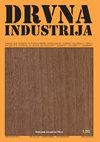中密度纤维板(MDF)回收方法对纤维尺寸和某些改造板性能的影响
IF 0.8
4区 农林科学
Q4 MATERIALS SCIENCE, PAPER & WOOD
引用次数: 1
摘要
在本研究中,对市场上广泛销售的100%山毛榉和70%山毛榉+ 30%松木纤维制成的纤维板进行了不同的回收方法测试,包括酸水解(磷酸和甲酸)、热水解和微波法。利用光学原理确定光纤尺寸的装置,研究了不同使用方法对光纤尺寸的影响。在实验室环境中,使用再生纤维构建了测试板,并研究了某些物理和机械品质的变化。结果表明,微波纤维和热水解纤维的再生纤维可以有效地用于纤维板生产。然而,对于100%山毛榉纤维组成的MDF样品,用磷酸法处理后,长度大于1.24 mm的纤维比例减少了约30%。除100%山毛榉纤维的磷酸法外,不能通过酸水解回收纤维制得纤维板。本文章由计算机程序翻译,如有差异,请以英文原文为准。
Effects of Medium Density Fiberboards (MDF) Recycling Methods on Fiber Dimensions and Some Reconstructed Board Properties
In this study, different methods, including acid hydrolysis (phosphoric and formic acid), thermohydrolysis, and microwave methods were tested for recycling of fiberboards made of 100 % beech and 70 % beech + 30 % pine wood fibers, which are widely sold in the market. The impacts of the using methods on the fibers were investigated with the help of a device that determines the fiber dimensions according to optical principles. In a laboratory setting, test boards were constructed using recycled fibers, and the changes in certain physical and mechanical qualities were studied. As a result, it was determined that recycled fibers obtained from microwave and thermo-hydrolysis fibers could be effectively used in fiberboard production. However, the proportion of fibers, longer than 1.24 mm, was decreased by about 30 % with the phosphoric acid method for MDF samples composed of 100 % beech fiber. The fiberboards could not be obtained from fibers recycled through acid hydrolysis except for phosphoric acid method with 100 % beech fibers.
求助全文
通过发布文献求助,成功后即可免费获取论文全文。
去求助
来源期刊

Drvna Industrija
MATERIALS SCIENCE, PAPER & WOOD-
CiteScore
1.80
自引率
9.10%
发文量
32
审稿时长
>12 weeks
期刊介绍:
"Drvna industrija" ("Wood Industry") journal publishes original scientific and review papers, short notes, professional papers, conference papers, reports, professional information, bibliographical and survey articles and general notes relating to the forestry exploitation, biology, chemistry, physics and technology of wood, pulp and paper and wood components, including production, management and marketing aspects in the woodworking industry.
 求助内容:
求助内容: 应助结果提醒方式:
应助结果提醒方式:


